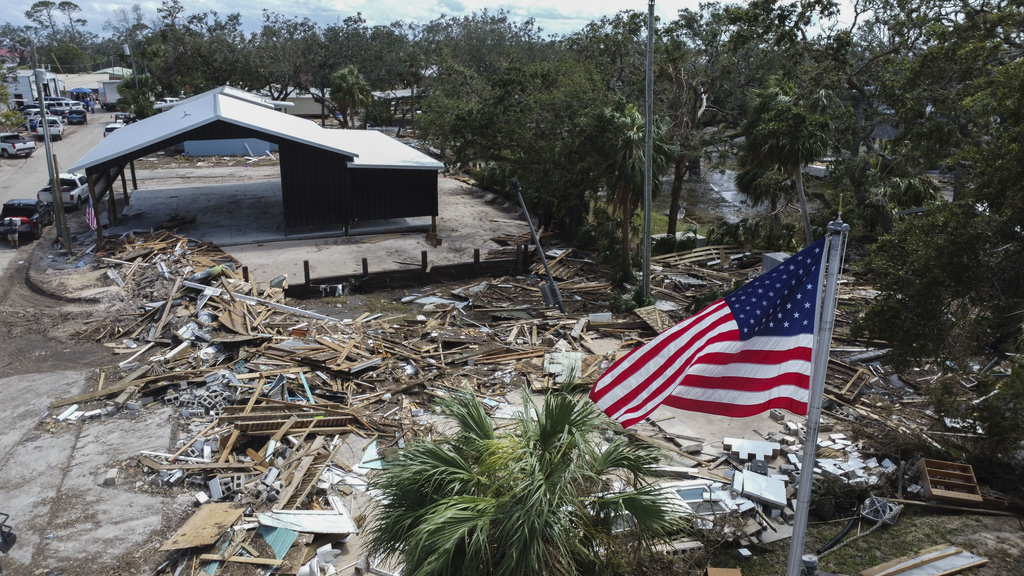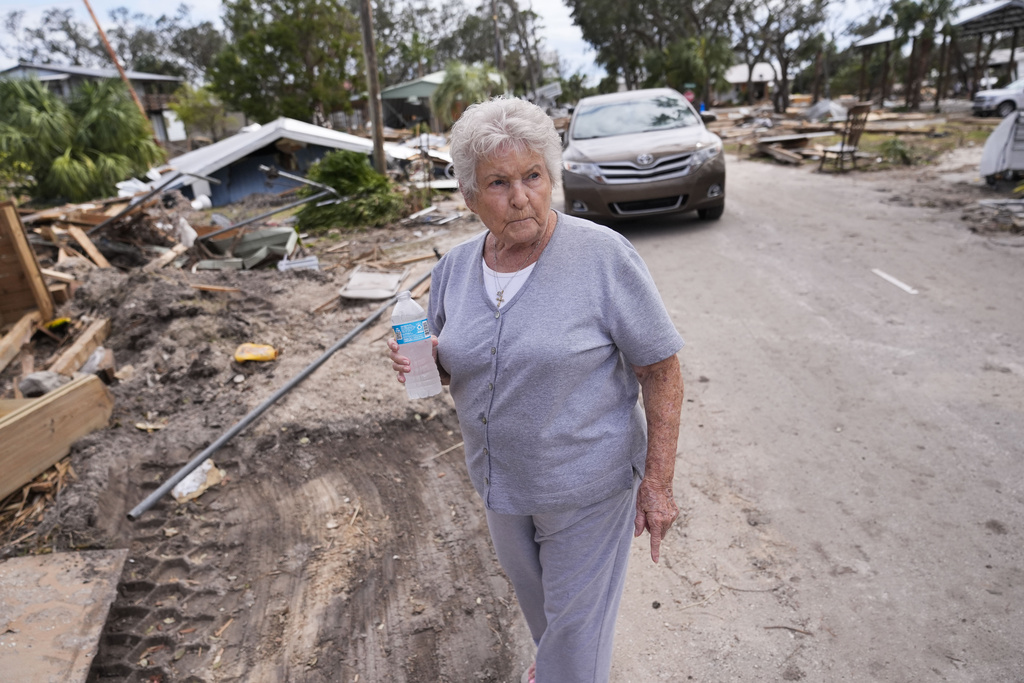Helene’s Impact: Floods, Destruction, and 52 Deaths Reported \ Newslooks \ Washington DC \ Mary Sidiqi \ Evening Edition \ Hurricane Helene struck Florida’s Big Bend region, causing massive destruction, flooding, and at least 52 deaths across the U.S. Southeast. Millions are without power as rescue and recovery operations are underway, with extensive damage reported in Georgia, the Carolinas, and Tennessee. The hurricane, now a post-tropical cyclone, continues to cause historic flooding and devastation.

Hurricane Helene’s Devastation Across the Southeast: Quick Looks
- Hurricane Helene, a Category 4 storm, hit Florida’s Big Bend, causing widespread destruction across the Southeast.
- The storm killed at least 52 people and left millions without power, uprooting trees and flooding neighborhoods.
- In Georgia, Gov. Brian Kemp compared the destruction to a bomb site after an aerial survey.
- Western North Carolina faced landslides and flooding, cutting off major highways, including Interstate 40.
- Dramatic rescues were carried out in Tennessee and North Carolina, with many people stranded in submerged areas.
- Power outages affected millions; 1.9 million homes were restored while hundreds of thousands remained without power.
- Moody’s Analytics estimated between $15 billion to $26 billion in property damage from Helene.
- President Biden vowed federal support to assist the Southeast in recovering from the catastrophic storm.
Deep Look:
Massive rains from Hurricane Helene left people stranded, without shelter, and awaiting rescue on Saturday as the Southeast began the grim process of cleanup after the storm’s path of destruction. Helene, a powerful Category 4 hurricane, struck Florida’s Big Bend region late Thursday, unleashing winds of up to 140 mph (225 kph) and carving a devastating route through Georgia, the Carolinas, and Tennessee. The storm killed at least 52 people, caused widespread destruction, and left millions without power, leaving communities grappling with the aftermath of one of the deadliest storms to hit the region in recent years.
Helene’s onslaught uprooted massive trees, shattered homes, flooded streets, and sent rivers surging over their banks. Tornadoes spun out from the storm’s fury, and dams across the Southeast came under severe strain. The sheer force of Helene’s impact was apparent throughout the region. Georgia Governor Brian Kemp, after surveying the damage from the air, remarked, “It looks like a bomb went off.”
Western North Carolina, in particular, experienced severe devastation. Landslides and flooding forced the closure of major routes, including Interstate 40, effectively isolating parts of the state. The situation has created significant challenges for emergency response teams attempting to reach affected areas and provide essential supplies.
Hundreds of water rescues have taken place since the storm hit, none more dramatic than in Unicoi County, Tennessee. On Friday, rescue helicopters airlifted dozens of hospital patients and staff stranded on a rooftop as floodwaters rose rapidly around the building. The rescues continued into Saturday in North Carolina, where portions of Asheville were submerged under water. “To say this caught us off-guard would be an understatement,” said Quentin Miller, Buncombe County sheriff, reflecting on the unprecedented nature of the flooding.
Emergency Services Director Van Taylor Jones noted that, while there were fatalities in Buncombe County, they were not yet ready to provide a detailed report due to communication outages that made it difficult to notify next of kin. With multiple cell towers down in the area, many residents have been left without the ability to contact family members. Francine Cavanaugh, whose sister went to check on guests at a vacation cabin near Asheville before losing contact, echoed the growing frustration and anxiety many families face. “I think that people are just completely stuck, wherever they are, with no cell service, no electricity,” she said.
Now downgraded to a post-tropical cyclone, Helene remained a powerful force as it hovered over the Tennessee Valley throughout the weekend. The National Hurricane Center warned that flooding could reach levels unseen in North Carolina for a century. In Atlanta, Georgia, floodwaters overwhelmed entire neighborhoods, leaving only car roofs visible above the deluge. A record 11.12 inches (28.24 cm) of rain fell over the city in just 48 hours—the most recorded in such a time frame since record-keeping began in 1878.
President Joe Biden called the devastation caused by Helene “overwhelming” on Saturday, pledging federal assistance to help the vast areas of the Southeast that were impacted by the storm. The hurricane is now the deadliest tropical storm in South Carolina since Hurricane Hugo killed 35 people in 1989. Deaths were also reported in Florida, Georgia, North Carolina, and Virginia.
The financial impact of Helene is expected to be severe. Moody’s Analytics has estimated between $15 billion and $26 billion in property damage, while AccuWeather predicts the overall economic loss to range from $95 billion to $110 billion. These figures reflect the staggering toll of destroyed homes, uprooted businesses, and damaged infrastructure across multiple states.
Climate scientists have pointed out that Helene’s rapid intensification was influenced by climate change, which has created conditions that allow storms to grow more powerful as they pass through increasingly warm ocean waters. Helene’s transformation into a Category 4 hurricane and the speed at which it escalated exemplify the broader trend of powerful cyclones forming in a matter of hours.
Evacuations took place before and after the storm’s landfall, with many continuing as lakes and rivers overflowed, causing additional concern for downstream communities. Among the impacted areas was Lake Lure in North Carolina, featured in the movie “Dirty Dancing,” where a dam was overtopped, prompting nearby neighborhoods to evacuate.
In Tennessee, Elin Fisher and her husband faced a series of challenges trying to stay ahead of the storm. They teach whitewater stand-up paddleboarding on the Nolichucky River, and had to move their camper three times to escape the rising waters, all while assisting others to move eight additional campers. Their story was one of many that illustrated both the resilience and camaraderie of those affected by Helene.
In Florida, the death toll rose to 11, with nine individuals drowning in their homes in Pinellas County, an area under mandatory evacuation orders. Sheriff Bob Gualtieri reported that despite evacuation orders, many chose to stay and were ultimately trapped by the storm surge. However, no fatalities were reported in Taylor County, where Helene made landfall, near the mouth of the Aucilla River. Reflecting on the storm surge, Florida Governor Ron DeSantis remarked, “If you had told me there was going to be 15 to 18 feet (4.57 to 5.49 meters) of storm surge, even with the best efforts, I would have assumed we would have had multiple fatalities.”
Taylor County, a region of salt marshes and pine forests, has seen a dramatic shift from rarely experiencing direct hits to enduring three hurricanes in just over a year. Long-time residents are beginning to refer to their community as part of a “hurricane superhighway.” John Berg, a resident of the small fishing town of Steinhatchee, said, “It’s bringing everybody to reality about what this is now with disasters.”
Despite the repeated devastation, there is a spirit of resilience among many residents. Betsy Hamelink, cleaning up damage in Horseshoe Beach, noted, “It’s heartbreaking and it’s physically and mentally exhausting, but it’s the price you pay to have a little teeny tiny piece of a paradise.”
In Perry, Florida, just north of the landfall site, residents faced a new set of challenges. With power out across the county, cars lined up at a free food distribution center as families struggled to secure basic necessities. Sierra Land, who brought her young sons and grandmother to the distribution site, said that although her home escaped major damage, the lack of power meant she had lost everything in her fridge. “We’re making it one day at a time,” she said.
The power grid across Florida and Georgia took a severe hit from Helene, with millions left without electricity. Thousands of utility workers were deployed to restore power, and by Saturday, electricity had been returned to more than 1.9 million homes and businesses, but hundreds of thousands remained in the dark. In Grovetown, a suburb of Augusta, officials hosted a cookout for residents and workers trying to make the best of the situation as freezers thawed and food supplies risked going to waste.
Georgia’s Emergency Management and Homeland Security Director, Chris Stallings, highlighted the ongoing focus on ensuring that roads to hospitals were reopened and that supplies could reach communities in need. This was particularly crucial in rural areas where flooding and fallen trees had blocked critical access routes.
Helene was the eighth named storm of the Atlantic hurricane season, which began on June 1. With record-warm ocean temperatures, the National Oceanic and Atmospheric Administration has forecasted an above-average hurricane season, and Helene’s catastrophic impact has highlighted the urgent need for preparedness and adaptation in the face of increasingly severe weather patterns.
As the cleanup begins, the Southeast faces a long road to recovery, with communities picking up the pieces from Helene’s devastating path. From major cities like Atlanta to small coastal towns like Perry, the impact of this storm will be felt for years, underscoring the powerful and unpredictable nature of an ever-changing climate.
Helene’s Impact







